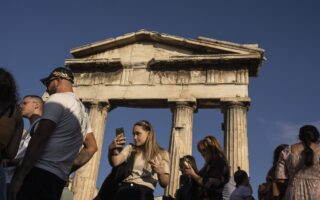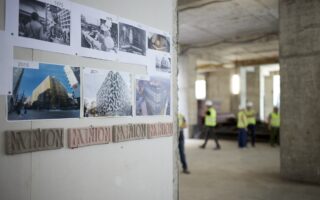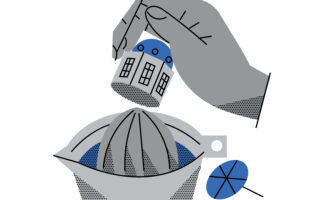Athens tourism: No rest for the weary

It is evident that the wooden benches near the Arch of Hadrian, in the heart of Athens, are not suitable for resting. Most tourists pass them by (thankfully) as they focus on taking photos with the arch in the background, toward Amalias Avenue. They tread on the coarse white pebbles under the August sun and are unlikely to translate the slogans on these dilapidated benches, which reflect contemporary Athenian culture.
A “Golden Dawn” slogan on one of these benches suggests that they have evaded the renovators for several years. They seem rather fitting beside the arch of an emperor who was an ardent admirer of Athens. They symbolically demonstrate that Hadrian’s affection was well-deserved and that modern Athenian culture upholds the city’s reputation.
These benches, after all, blend seamlessly with the general neglect of the area. The scene is one of widespread disarray. In front of the nearby Zappeion Hall, the state of the gardens and the dead branches left for who knows how long offer a poor impression of Athens and the way its citizens and officials manage their daily environment.
The dilapidated and vandalized benches next to the arch reveal that no ‘responsible’ official actually bothers to walk around the city
These dilapidated and vandalized benches next to the arch fulfill their symbolic role. What’s most telling is that they reveal that no “responsible” official actually bothers to walk around the city. If someone were to walk around and observe the condition of basic infrastructure near Athens’ major attractions (such as the Arch of Hadrian, the Philopappos Monument, the Pnyx, the Odeon of Herodes Atticus, and Ardittou Street with its beautiful view of the Panathenaic Stadium), the very least one would do is take prompt action. Out of a sense of shame and responsibility, at the very least. But evidently, no one is walking around. Opinions about the city and its monuments are formed in offices and meetings, not from direct experience. This is the fundamental issue: the impression of the city rather than engaging with it firsthand.
Meanwhile, we continue to take pride in the number of arrivals in a city that does not care to improve itself every day. The benches at the Arch of Hadrian are not an exception. However, they acquire a symbolic significance regarding the true quality of the tourism experience. They also reflect how much we care for Athens and reveal a Greek reality that, because of our immersion in it, we fail to overcome.
I walked from the National Museum of Contemporary Art Athens (EMST) to Syntagma Square with dozens of tourists. Everyone endured the heat as best they could and seemed pleased to be in the Greek capital. However, I did not see a single spot that would receive a passing grade (crosswalks, sidewalks, architectural environment, cleanliness).
Let’s at least be honest with ourselves and work with self-respect. A grand, genuine walk could encompass the entire area around the Temple of Olympian Zeus: Vasilissis Olgas Avenue, Athanasiou Diakou Street, Ardittou Street, and Amalias Avenue. Today few would be able to complete this circuit and truly enjoy it, what with the exhaust fumes, noise pollution and architectural degradation. And if they wanted to rest on a bench, use the restroom, or drink water, they would have to think twice.





